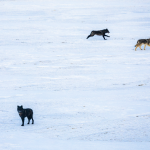Summit Outside: The high-flying golden eagle
Special to the Daily

ALL |
Although the bald eagle is the American symbol, the golden eagle is actually one of the largest, fastest, most agile raptors in North America. One golden eagle was measurement with an amazing wingspan of 9.2 feet and a weight of 27 pounds.
When seen soaring high above, the head appears relatively small and the tail very long. The wings are broad like a red-tailed hawk’s, but longer. Adult golden eagles are dark brown with gold-colored feathers on the back of the head and neck. Their beak is powerful and sharp, and they have sharp talons and can tear apart prey. Young birds have neatly defined white patches at the base of the tail and in the wings. Their legs are feathered all the way to the toes.
Golden eagles seem to prefer the rough broken terrain of foothills, mountains, valleys, rim rocks and steep ridges and slopes, and they often hunt the adjacent plains for food. Bald eagles seem to prefer timbered areas along coasts, large lakes and rivers, but they also can be found in other areas. In Colorado, golden eagles breed primarily in montane habitats in the west and canyon habitats in the southeast, and there is some limited breeding in northeast Colorado. In winter, golden eagles range more widely, and occur commonly throughout Colorado.
Golden eagles may dive in pursuit of rabbits and other small mammals such as ground squirrels and prairie dogs which are their main food source. They also prey on a variety of other birds. They sometimes attack large mammals like domestic livestock, or can fight off coyotes or bears in competition for prey or defending their young. Where golden eagles prey on domestic animals, they usually take lambs and kids, but some become persistent predators of domestic livestock as large as 500 pounds. They capture prey on or near the ground as they soar and fly low over the ground. Nearly 200 species of mammal and bird have been recorded as golden eagle prey.
Experiments with captive eagles indicate that adults require about 3/4 pound of meat per day to maintain their weight and young, growing eagles require much more food. Experiments indicate that without wind to assist them, even large eagles cannot take off from flat ground with more than 5 or 6 pounds in their talons. Eagles flying into the wind and taking prey from hillsides, however, sometimes carry animals of twice those weights for considerable distances.
Golden eagles are usually seen alone or in pairs, and maintain territories as large as 60 square miles. They may remain with their mate for several years or possibly for life. Golden eagles nest in high places including cliffs, trees or telephone poles. They build huge nests which can be 5-6 feet across and 3 feet high and they may return to the same nest for several breeding seasons. These nests consist of heavy tree branches and may also include bones, antlers and objects such as wire and fence posts. They line the nest with whatever local vegetation is available, such as yucca, grasses, bark, leaves, mosses and lichens or conifer boughs. They may often include aromatic leaves which may serve to keep insect pests away. They repair their nests whenever necessary and enlarge them during each use.
Diving from great heights, golden eagles engage in an undulating territorial and courtship display known as “sky-dancing.” An eagle trying to impress his mate may perform a rapid series of up to 20 steep dives and upward swoops, beating his wings three or four times at the top of each rise. They have been clocked at a diving speed of close to 200 mph. They have also been seen engaging in aerial play with objects such as sticks or a dead prey. They will carry these items high into the sky, then drop and retrieve them.
Females lay from one to four eggs, and both parents incubate them for 40-45 days. They are covered in fluffy white down and are fed for 50 days before they are able to fly and eat on their own. In most cases only the older chick survives, while the younger one dies. The older chick has a few days’ advantage in growth and consequently winning most squabbles for food. Typically, one or two young survive to fledge and leave their nest in about three months.
Eagles often abandon habitat that is subject to intensive human activity and move to more remote areas.
Golden eagles have been used in falconry since the Middle Ages. In Asia, they were used in teams to hunt animals such as deer, antelope and wolves. They were used for hunting by the nobility in Europe.
The golden eagle is the most common “national animal” in the world. Five nations use the golden eagle as their national symbol: Albania, Germany, Austria, Mexico and Kazakhstan. The golden eagle is the eighth-most common bird depicted on postage stamps with 155 stamps issued by 71 stamp-issuing entities.
Some Native American peoples revere golden eagles as sacred and the feathers are often worn on headdresses. In native ceremonies they symbolize noteworthy achievements and qualities such as exceptional leadership and bravery. The golden eagle is thought to be the origin of the thunderbird legends of the Southwestern United States.
Because of their power and size, the golden eagle has long inspired both reverence and fear.
Breckenridge resident Dr. Joanne Stolen is retired from teaching microbiology at Rutgers University.

Support Local Journalism

Support Local Journalism
As a Summit Daily News reader, you make our work possible.
Summit Daily is embarking on a multiyear project to digitize its archives going back to 1989 and make them available to the public in partnership with the Colorado Historic Newspapers Collection. The full project is expected to cost about $165,000. All donations made in 2023 will go directly toward this project.
Every contribution, no matter the size, will make a difference.









